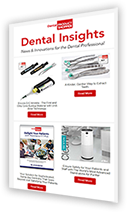NOBEL BIOCARE
Opening a New Chapter in Implant Dentistry
Nobel Biocare unveils breakthrough technology that experts say will change the way clinicians approach implant dentistry
 There’s strength in numbers. When teams of innovators spend decades working toward a common goal, the insights gained during their journey can be revolutionary. This is especially true when the worlds of medicine, dentistry, and science come together to open new doors into the future of patient care.
There’s strength in numbers. When teams of innovators spend decades working toward a common goal, the insights gained during their journey can be revolutionary. This is especially true when the worlds of medicine, dentistry, and science come together to open new doors into the future of patient care.
After decades of research and development by an international network of researchers, engineers, and clinicians, Nobel Biocare has not only gained a unique understanding of where implant dentistry could go—it has developed an integrated portfolio of technologies with the potential to change the way clinicians approach implant dentistry.
To celebrate these innovations, over 1,200 dental professionals from more than 60 countries gathered in Madrid, Spain, for the Nobel Biocare Global Symposium. Over the course of the 3-day event, attendees took part in interactive presentations and hands-on workshops while hearing from world-renowned experts in implant dentistry. They also earned a sneak peek behind Nobel Biocare’s newest technologies—the Nobel Biocare N1 implant system, Xeal abutment surface, and TiUltra implant surface.
“The symposium was an incredible experience where so many groundbreaking implant innovations were first shown to the market,” said Dr. Peter Wöhrle, Chairman of the Global Symposium’s Scientific Committee. “The reaction of those in attendance was overwhelming, as they observed the development and science behind the Nobel Biocare N1 implant system, and then had an opportunity to work with it in hands-on workshops. Dentists were excited to see what this could mean for their patients and practice.”
Breaking Ground, Not Bone
Years ago, Dr. Jill Helms, noted biologist and professor in the Division of Plastic and Reconstructive Surgery at Stanford University, met with the Nobel Biocare team and several engineers to discuss what would later become the Nobel Biocare N1 implant system. They made a list of what this new implant system should accomplish: omit the need for irrigation, avoid generating heat, treat the bone better, and improve site preparation. Dr. Helms reflected on her initial impression of the concept and design: “I remember the moment I looked at it, and I thought, ‘Oh, this is going to be different.’”
But was it possible to prepare bone in a new way? “Most of the drills that are used to cut bone are actually predicated on a drill design for cutting metal,” explained Dr. Helms. “Although metal and bone are both hard materials, one is living and the other is not. So, optimal site preparation involves maintaining the viability of bone.”
The Nobel Biocare N1 implant system addresses this challenge through a new site preparation method centered around the OsseoShaper—an innovative alternative to conventional drilling protocols that shapes the site by cutting dense bone and compressing porous bone.
“I was, as most scientists are, skeptical,” Dr. Helms acknowledged, adding that she kept her expectations in check during the first trial. “I must admit to being absolutely surprised by how efficiently it cut bone, but I was even more impressed by how gentle it was to the bone. And I immediately knew that this was going to be a paradigm shift.”
"I believe this is an indicator of a new standard that will be set in implantology."
-Dr. Peter Wöhrle
Next-Level Surface Science
Decades of applied anodization research is taking tissue integration solutions to the next level. In going beyond osseointegration, Nobel Biocare created the pioneering Mucointegration technology behind its Xeal abutment surface and TiUltra implant surface. The surface chemistry and hydrophilicity of both Xeal and TiUltra is preserved through a liquid dissolving protective layer that ensures the quality of the implant and abutment surfaces is maintained from production to placement.
“The careful control of surface topography and surface composition is a key merit of the Xeal abutment,” observed Dr. John Brunski, whose research has largely focused on bioengineering aspects of implant design, bone-implant interactions, and the biomechanics of bone healing. “The reason for focusing on Mucointegration is to emphasize that the soft tissues and their interaction with the implant surface are every bit as important in implant success as osseointegration.”
 Xeal demonstrates a significant increase in soft-tissue height compared to machine abutments. The surface is smooth, nonporous, nanostructured, and anodized to promote soft-tissue attachment and protect the underlying bone. TiUltra matches Xeal through an implant surface that is anodized
Xeal demonstrates a significant increase in soft-tissue height compared to machine abutments. The surface is smooth, nonporous, nanostructured, and anodized to promote soft-tissue attachment and protect the underlying bone. TiUltra matches Xeal through an implant surface that is anodized
with a specific electrolytic solution to enhance the chemical composition of the oxide layer. The result is an ideal interaction between the implant surface and proteins that leads to longterm tissue stability.
“I believe it is important to look at the introduction of TiUltra as part of a combined system with Xeal to optimize tissue integration at every level,” stated Dr. Wöhrle, noting the long-term health benefits for implant patients when dentists combine osseointegration and Mucointegration during treatment.
Of Nobel Biocare’s latest implant innovations overall, Dr. Wöhrle concluded, “I believe this is an indicator of a new standard that will be set in implantology.”
The Mechanics Behind N1
Dr. John Brunski, a Senior Research Engineer in the Division of Plastic and Reconstructive Surgery at Stanford University, discusses the biological mechanics of the Nobel Biocare N1 implant system, distinguishing its top 3 features:
•Unique Site Shaper
The Nobel Biocare N1 implant system involves a completely new way of preparing the implant site by using the OsseoShaper. This is not a conventional high-speed irrigated drill, but instead a “site shaping” device than can cut dense bone while only compressing porous bone—all in the absence of irrigation.
•A Gentler Cut
 The OsseoShaper rotates clockwise at a low rpm while entering into bone, and then counterclockwise when exiting, thus producing much less heat than a conventional high-speed drill. It also encourages bone chips to remain in the site, where the chips can then serve as substrates for new bone formation.
The OsseoShaper rotates clockwise at a low rpm while entering into bone, and then counterclockwise when exiting, thus producing much less heat than a conventional high-speed drill. It also encourages bone chips to remain in the site, where the chips can then serve as substrates for new bone formation.
•Intuitive Design
The tapered Nobel Biocare N1 implant is designed with a trioval cross-sectional shape at its crestal one-third, which has the effect of producing small gap regions of low stress and strain in between the 3 “lobes” of the trioval shape that engage with bone during insertion. These low stress and strain gap regions can fill with new bone to help stabilize the implant as the damaged pre-existing bone near the lobes is remodeled.





